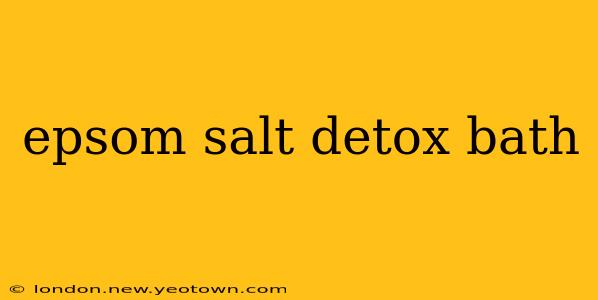Imagine sinking into a warm, soothing bath, feeling the tension melt away as the water gently surrounds you. Now, picture adding a potent ingredient: Epsom salt. This isn't just any ordinary bath; it's an Epsom salt detox bath, a practice touted for its potential health benefits. But what's the science behind the hype? Is it truly a detoxifying experience, or simply a relaxing soak? Let's unravel the mysteries surrounding this popular wellness ritual.
What is an Epsom Salt Detox Bath?
An Epsom salt detox bath involves dissolving Epsom salts (magnesium sulfate) in warm bathwater and soaking for a period of time. Proponents claim that this practice draws toxins from the body through the skin, promoting relaxation, reducing inflammation, and improving overall well-being. But before we jump to conclusions, let's look at the evidence. The story of Epsom salts is a fascinating one, dating back centuries, with its use evolving from a medicinal remedy to a modern-day self-care ritual.
Does an Epsom Salt Bath Actually Detoxify Your Body?
This is the million-dollar question. While the term "detox" is often used loosely in the wellness world, the idea of an Epsom salt bath drawing out toxins needs some clarification. The body already has highly efficient systems—the liver and kidneys—that naturally detoxify. Epsom salt doesn't magically bypass these systems. However, the magnesium in Epsom salt can be absorbed through the skin, offering potential benefits.
How Does Magnesium Absorption Work?
Magnesium is an essential mineral involved in hundreds of bodily processes, from muscle function to blood sugar control. When you soak in an Epsom salt bath, a small amount of magnesium is absorbed through the skin, potentially supplementing your magnesium levels. This can be particularly beneficial for individuals with magnesium deficiencies.
What are the Potential Benefits of an Epsom Salt Bath?
Even without the dramatic "detox" claims, Epsom salt baths offer several potential benefits supported by some research:
-
Muscle Relaxation and Pain Relief: Magnesium's role in muscle function makes it a potential aid in relieving muscle soreness and aches. The warm water itself also contributes to muscle relaxation.
-
Stress Reduction: A warm bath is inherently relaxing, and the Epsom salts can further enhance this effect, potentially reducing stress and anxiety levels.
-
Improved Sleep: Magnesium plays a role in sleep regulation, and an Epsom salt bath may improve sleep quality for some individuals.
-
Skin Softening: The magnesium sulfate can help to soften and hydrate the skin.
How to Take an Epsom Salt Detox Bath?
Taking an Epsom salt bath is simple:
-
Fill your tub with warm (not hot) water. Hot water can dehydrate you.
-
Add 2-3 cups of Epsom salts. Experiment to find the amount that feels most comfortable.
-
Soak for 20-30 minutes. Relax and enjoy the experience.
-
Rehydrate afterwards. Drink plenty of water to replace any fluids lost.
Are There Any Side Effects or Precautions?
While generally safe, Epsom salt baths can have some side effects:
-
Dehydration: Hot water can dehydrate you, so stay hydrated.
-
Skin Irritation: Some individuals may experience skin irritation. Start with a small amount of Epsom salts and monitor your skin's reaction.
-
Low Blood Pressure: Individuals with low blood pressure should consult their doctor before taking Epsom salt baths.
Epsom Salt Bath vs. Other Detox Methods: Is it Worth it?
Compared to other purported "detox" methods, Epsom salt baths are relatively safe and inexpensive. However, remember that true detoxification relies on your body's natural processes. While an Epsom salt bath might offer some therapeutic benefits, it shouldn't replace healthy habits like a balanced diet, regular exercise, and adequate hydration.
What are the best Epsom salts to use for a detox bath?
The purity of the Epsom salt is key. Look for brands that clearly state they're pharmaceutical grade or 100% pure magnesium sulfate. Avoid those with added fragrances or dyes, especially if you have sensitive skin.
How often should I take an Epsom salt bath for detox?
There's no set frequency. Listen to your body. Some people find it beneficial once or twice a week, while others might do it less often. Avoid overdoing it, as excessive soaking can dehydrate you.
Can I add essential oils to my Epsom salt bath?
Yes, many people enjoy adding a few drops of essential oils to enhance relaxation. Lavender, chamomile, and eucalyptus are popular choices. However, always test a small amount on your skin first to check for any allergic reactions.
In conclusion, while the "detox" aspect of an Epsom salt bath might be slightly overstated, the relaxing and potentially therapeutic benefits make it a worthwhile addition to a self-care routine. Remember, a holistic approach to well-being, including a healthy lifestyle and consultation with a healthcare professional, is always the best path to optimal health.

